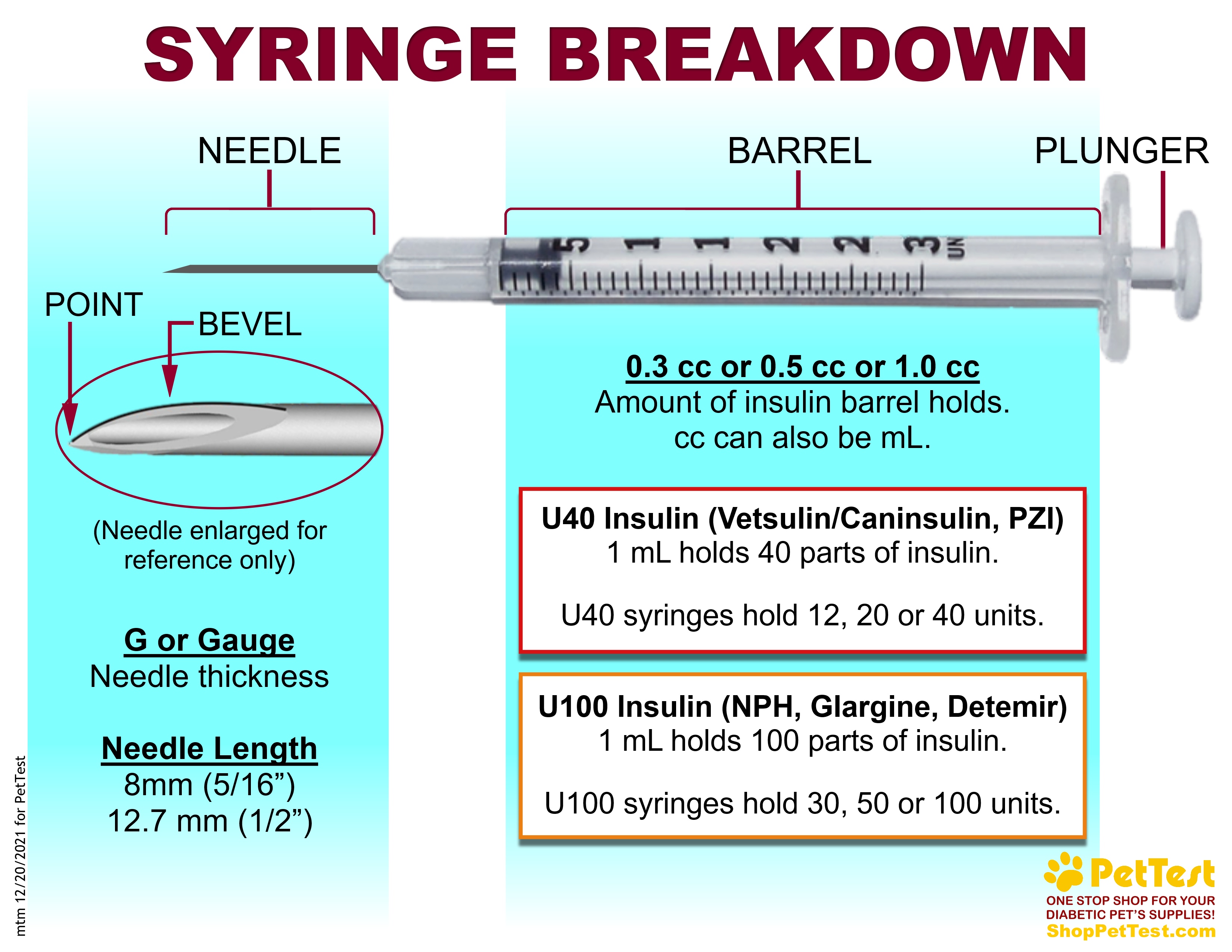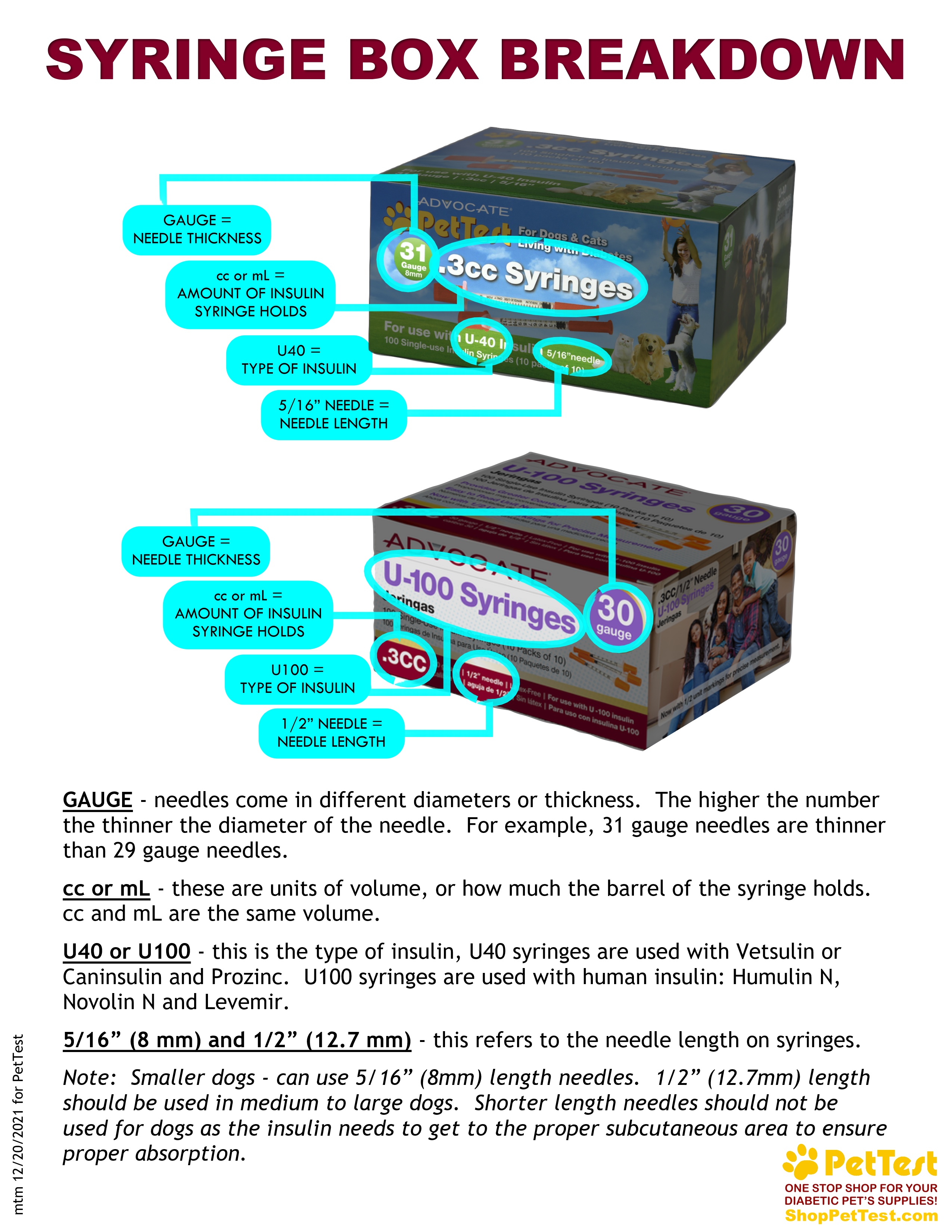Diabetes 411: Terminology Explained
You join a group on Facebook or a forum to learn what you can about canine diabetes and gain support with like minded people, but when you read posts and comments your head spins. What the heck does fasting mean? What is BG? What are all these numbers on syringe boxes? Don’t worry we have all been there, especially if we don’t work in the medical field. I looked at the syringe box and thought I was on a different planet!
Today I want to go over the most common terminology the diabetic dog veterans use that we most often see in our Facebook group Diabetic Dog Owners.
Grab a cup of your favorite caffeinated beverage and let’s get to it!
INSULIN WE USE:
- Vetsulin / Caninsulin – this is a U40 insulin that is specifically used for companion animals (dogs and cats). It is a combination intermediate-acting insulin. 35% is an amorphous insulin that kicks in faster to help with food spikes and 65% is crystalline insulin and acts like a true intermediate insulin. This insulin should be given every 12 hours.
- NPH insulin – this is a U100 intermediate-acting human insulin. Common names for this insulin are: Humulin N and Novolin N. Both insulins cost approximately $150 at most pharmacies in the USA. Novolin N can be purchased at Walmart for $24.88 in the USA. NPH insulin should be given every 12 hours.
- Levemir insulin – this is a U100 long-acting human insulin. Typically dogs with rapid metabolism are given Levemir every 12 hours.
INSULIN TYPES : there are several types of insulin used in dogs.
- Regular or fast-acting insulin – used in veterinary settings to reduce blood glucose levels quickly. This type of insulin starts working in under an hour, peaks in two to 2.5 hours and lasts for up to four hours. This insulin typically is not used at home since continuous monitoring of blood glucose levels is necessary, its short duration and its ability to drop blood glucose levels quickly.
- Intermediate-acting insulin – the most common type of insulin used in dogs, onset is approximately two hours post injection, peaks in approximately four to six hours and lasts for up to 12 hours. Humulin N and Novolin N are intermediate acting insulins. Vetsulin / Caninsulin is intermediate acting insulin with two peaks, the first peak is approximately two hours post injection and the second peak is approximately eight hours post injection.
- Long-acting insulin – in humans long-acting insulin lasts up to 24 hours, but in dogs typically lasts 12 hours. Levemir has a peak of four to six hours.
WHAT DO U40 AND U100 MEAN?
- U is short for units.
- U40 insulin has 40 parts of insulin per 1 mL.
- U100 insulin has 100 parts of insulin per 1mL.
WHAT DOES PEAK MEAN?
Peak is the time when the effect of insulin is at optimal strength.
VIALS
A vial of insulin has 10 ml in it.
- If you are using Vetsulin/Caninsulin, the vial has 400 units of insulin.
- If you are using a 10 ml vial of NPH insulin it has 1000 units of insulin in it.
PEN CARTRIDGES / PENFILLS
- Vetsulin / Caninsulin “Vetpen” cartridges have 2.7 mL of insulin in them. There are 108 units in each cartridge.
- NPH and Levemir cartridges have 3 mL of insulin in them. There are 300 units in each cartridge.
WHAT DOES MG/DL MEAN?
mg/dL stands for milligrams per deciLiter. This measurement is used for reading blood glucose in the USA.
WHAT DOES MMOL/L MEAN?
mmol/L stands for millimoles per Liter. This measurement is used for reading blood glucose globally except for the USA.
WHAT IS CC OR ML?
cc is short for cubic centimeter and mL is short for milliliter. These are the same measurement; there is no difference in volume, 1 cc equals 1 mL. Milliliters (mL) are used for fluid amounts and cubic centimeters (cc) are used for solids.
Now let’s go over syringes quickly! The graphic below is a breakdown of syringes.

And finally, let’s look at syringe boxes and what all those numbers mean!

I know this is a lot of information for you, especially if you are new to canine diabetes. Please feel free to download this blog out and print it for future reference, having something on hand is often much easier.
I want to take a quick second to wish you all a very Happy New Year! I hope that 2022 is a fabulous year for all of us!
Until next week stay comfy and caffeinated!
If you have any questions, comments or suggestions, please start a conversation below.
If you are looking for a Facebook community to join for support, I have proudly been an admin in Diabetic Dog Owners for almost five years. You can also join Canine Diabetes Support and Information on Facebook as well.
Be sure to join the PetTest family on Facebook and Instagram. PetTest has fun, interactive posts AND they have fabulous giveaways every week!
Do you need a blood glucose meter kit for your diabetes arsenal? Click here to purchase one today!
For a printable version of this blog click here.

